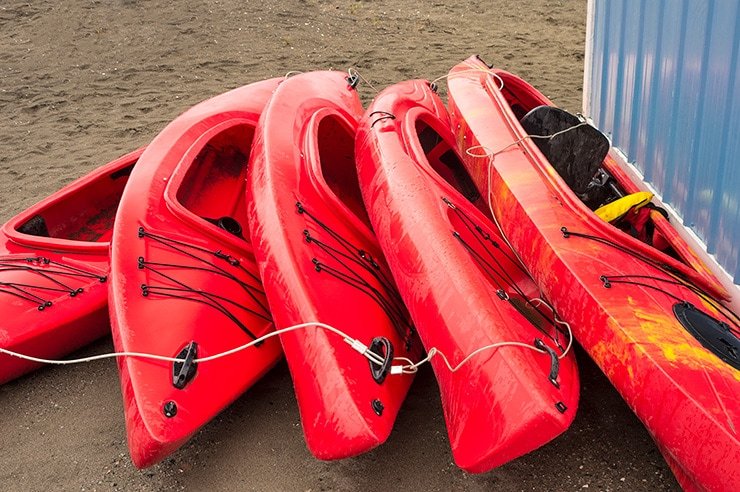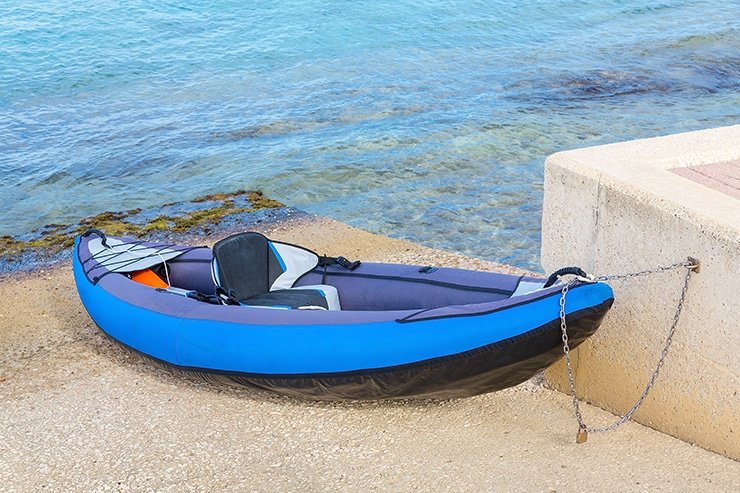Learning how to lock up a kayak properly is often an afterthought in most kayakers’ minds, but it’s vital to prevent both theft and damage. However, before diving in, you must consider a few things.
We’ll be covering everything you need to know and consider to keep your kayak safe and secure, no matter if you’re traveling long distances with it, or anchoring down on the beach.
Key Takeaways
- You need to lock your kayak properly to prevent theft and damage.
- You can use cable locks or locking straps to secure your kayak to a solid anchor point, such as a dock, fence, or railings, or to another kayak.
- Use scupper holes, handles, or other holes to loop the cable around your kayak, and make sure there is no slack in the cable.
- You can also lock your kayak to a roof rack for transportation, using locking straps or cable locks.
- Locking your kayak is a deterrent for most thieves, but it is not foolproof, so you should be careful and vigilant too.
What Kind of Kayak Are You Locking Up?
The first thing to consider is the type of kayak you own as the way to lock up your kayak will differ depending on this. There are multiple types of kayak, but they generally fall under the following three varieties:
- A sit-inside kayak
- A sit-on-top kayak
- Inflatable kayaks
There are similarities in how these three are locked, but there are also some key differences that may affect the kind of lock you use or the location you choose to lock your kayak down.
Choosing the Right Lock for Your Kayak
A good kayak lock can come in all kinds of configurations. Most locks will be some kind of cable lock but you can also get locking straps to lock your kayak to a roof rack. A good kayak cable lock will often be made of braided steel and have some kind of vinyl coating.
Locking straps are also made of resistant materials (like aircraft-grade aluminum) and you can get traditional key padlocks or a combination lock.
You don’t necessarily have to buy the thickest kayak cable lock you can find, quarter inch cables are usually fine. They’re much easier to move around, and there’s less hassle to fit them through scupper holes.
It’s also not necessary to purchase a longer cable lock either, it’ll take up more space than it needs to and any excess cable can flop around and potentially cause you difficulties down the line.
While it’s tempting to think that thicker locks are safer this isn’t quite true; no cable lock can prevent someone with the right tool from cutting it, but the majority of thieves aren’t that prepared. The lock itself is what acts as the deterrent.

Locking a Sit-Inside Kayak
To lock sit-inside kayaks you’ll need a bit of finesse, and while some recommend using or installing a drain hole, this isn’t always a practical option for everyone. A lack of scupper holes (these holes help sit on top kayaks with structural integrity and drainage), makes a bit of practice most likely needed for the locking method described below to work.
If you have a sit-inside kayak, you will need to invest in a dedicated cable lock; these have locking loops at both ends, making everything much easier.
Step 1: Find a Suitable Anchor Point
First, you’ll need to look for a good anchor point. In some cases (depending on where you’re kayaking), there will be specific anchor spots for kayakers to lock their kayaks to, but this isn’t always the case. A suitable anchor point is something with a decent amount of weight that will keep your kayak in place.
Most waterfronts will have some kind of structure – like a dock, fence, or railings – that you can anchor your kayak to fairly easily. Anything attached to the landscape or with a decent amount of weight that can hold your kayak in place is a great anchor point.
Step 2: Place the Cable Around Each End
Sit-inside Kayaks usually don’t have scupper holes that you can use to push your cable lock through. Take your cable lock and loop one end around the stern (back) and one around the bow (front) of the kayak.
Make sure that the cable lock isn’t too long or doesn’t have too much slack.
Step 3: Wrap the Center of the Cable Around the Anchor Point
Take the center of the cable and wrap it around your chosen anchor point. Double-check that there isn’t any slack in the cable that a would-be thief can use to slide some of the cable off of the kayak.
You’ll then want to place either your padlock or combination lock at the base of the stern (rear) loop. This will lock the kayak into place, and keep the table tight around it.
Locking Sit-Inside Kayaks Together
Most of the time you’re going to want to find an anchor point to lock your kayak to, and if you’re a solo kayaker then it’s pretty much your only option. However, if there are two kayaks (or more), then you can lock them together.
It’s going to be incredibly difficult for anyone to steal a couple of kayaks that are locked together, so in a way, they form their own anchor point.
Locking sit-inside kayaks together requires a bit of finesse, you’re going to have to find points on your kayak to feed the cable through. but there are often small holes bolted around your kayak at the bow and stern (this is why thin cable locks are a great idea for sit-inside kayaks).
Simply feed the cable lock through any holes you can find and wrap the cable around both kayaks, the cable should be fairly snug.
Locking a Sit on Top Kayak
It’s much simpler to lock sit-on-top kayaks, the anchor point method for locking them is much less involved than with other types of kayaks.
Step 1: Choose an Anchor Point
As mentioned, choose a good, solid anchor point, there should be spots that you can use to tie your kayak too – whether it’s wooden structures or docking areas, even a large tree if there’s any nearby.
Step 2: Find the Scupper Hole
The scupper holes are usually located in the cockpit, foot walls, or tank well, and there can be anything from one to six of the holes. These scupper holes are usually large enough to allow even fair thick cable through.
Once you’ve found your scupper hole you’ll want to start feeding the cable through the holes.
Step 3: Loop the Cable Around the Anchor Point
Loop your cable around your anchor point and then feed it through one of the opposing scupper holes. Tighten the cable, attach the lock (if your locking mechanism is separate from the cable) and you’re good to go.
Locking Sit on Top Kayaks Together
Locking sit-on-top kayaks are exactly the same as locking them to an anchor point. However, in this case, you’re simply using the scupper holes to link all the kayaks together and then lock them.
The kayaks act as an anchor point and unless your potential thief is superman strong, they’re unlikely to be able to drag multiple kayaks very far.
Locking an Inflatable Kayak
Inflatable kayaks have become very popular, they’re easy to store and move around, and locking up an inflatable kayak is similar to a sit-inside kayak.
However, you need to bear in mind that an inflatable kayak can be punctured – so locking it up will not be the same process as you’re used to with hard shell kayaks.
Locking up and leaving a normal kayak unattended is one thing, but inflatable kayaks in particular just aren’t as sturdy. To lock up an inflatable kayak, you can use the following steps:
Step 1: Deflate the Kayak (optional)
To reiterate, it’s not a bad idea to simply just deflate your kayak and lock it up in a car, garage, or local storage facility when you aren’t using it. There are air pumps that can fit in your car that will quickly reinflate your kayak.
Step 2: Place the Cable Around Each End
Similar to the sit-inside kayak, you’re going to want to loop the cable around each end (front and rear) of the kayak. You’re going to want a dedicated kayak lock for this, as they’ll come with locking loops.
Some inflatable kayaks might have handles that you can use to feed the cable lock.
Step 3: Find an Object to Anchor the Kayak
Find a sturdy object to which you can attach your kayak and then make sure that the cable doesn’t have too much slack.
Step 4: Wrap the Center of the Cable Around the Anchor Point
Wrap the center of the cable around the anchor, it doesn’t matter if the object that you’re attaching your kayak to is on the ground or vertically upright, so long as you can wrap the center of the cable around the point.
Once that’s done, attach or set up the lock on one of your locking loops.
How to Lock a Kayak to a Roof Rack
Learning how to lock kayaks in a fixed spot isn’t the whole story – it’s handy to learn how to lock up a kayak to a roof rack for transportation too. This is especially important if you travel frequently and your kayak comes with you.
Using Locking Straps
Locking straps are incredibly simple to use, simply use them to tie your kayak to the bars on your roof rack, just take care everything is snug and the lockable straps will ensure that the kayak stays rooted in place.
Using Cable locks
You can use a loop-style cable lock in the same way that you’d tie a sit-inside kayak to an anchor point. The cable underneath wraps around the bars on the roof rack.
Conclusion
Unless you’re leaving your kayak unattended for long periods of time you shouldn’t get too concerned about kayak theft. It is fairly heavy boating equipment and it’s going to be difficult for any thief to steal one that’s been locked up, the vast majority of thieves will be put off just by simply seeing a lock.
We hope you’ve enjoyed reading up on how to lock up a kayak, please share this with anyone who you think may find the information useful and comment with your own hints and wisdom.


Instead of using tie-down straps, you can secure your kayak with tamper-proof chains or cable locks. Most seasoned kayakers advise using the Kryptonite Fahgettaboudit Chain, which has a double deadbolt lock with superior reinforcement and links made of 14 mm-thick 3T manganese steel.